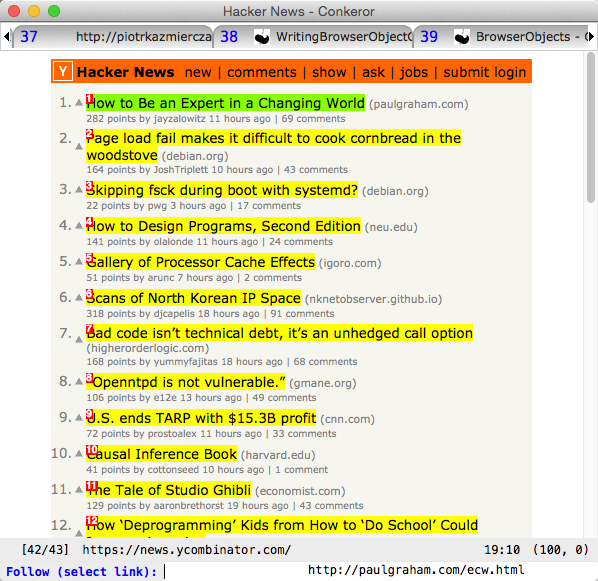If you have not known what Conkeror is, you probably miss one of the greatest web browser in your life. Read this post for an introduction of how impressive Conkeror is Conkeror and How it changed the way I surf the web.
Overview
One of the most interesting feature that Conkeror brings from Emacs is the Browser Object. If you are coming from an Emacs background, you are not unfamiliar with universal-arguments, which can modify the function’s behaviour once it is called before activating the function. Browser Objects in Conkeror brings that idea from Emacs to the web environment but with better approach. Browser Objects in Conkeror can represent practically any type of data (e.g image, hyperlinks, frame,…).
Quote from Conkeror Wiki page
In the web environment, there are many data types which one wants to manipulate. Text, hyperlinks, images, form fields, to name just a few. Without some kind of abstraction layer to unify the interface to all these types of objects, it would be necessary to have a combinatorially large number of commands. For instance, you would need separate commands for follow-link, follow-image, and follow-frame. With browser objects, you have just one command, follow, which can operate on many types of data.
Using Browser Objects Commands
Browser Objects commands are prefix commands and they have the attributes just
like normal command in Conkeror. You can activate them with M-x, you can
bind them to a key stroke with define_key. All of them are named with a prefix
browser-object-. Once activated, they will change the interactive context of
the next command invoked.
For example, the save command (which is default bound to s), prompts for a
link to save to your computer. Now, try to modify it using the
browser-object-images command to make it prompt for images to download.
The command is bound to i be default so you can just type i s instead of
just s to select the image you want to download. Of course you can active it
with M-x browser-object-images M-x save.

Some useful tips
Conkeror already comes pre-built with many browser objects commands that you can use
Images
i f-browser-object-imagesfollow: follow imagei s-browser-object-imagessave: save image
Copy
* * c-browser-object-dom-nodecopy: copy DOM node text (very useful to copy block of text)i c-browser-object-imagescopy: copy image link* a c-browser-object-altcopy: copy image alt text
There are many other browser objects that are waiting for you to explore
Defining Browser Objects Class and Commands
The Browser Object commands are generated automatically by Conkeror when you
create the Browser Object class. The function define_browser_object_class is
used to define the Browser Object class. You need to supply it at least 3
arguments, these are the name of the browser object (in hyphenated style), the
doc string of it and the handler (will talk later). The final optional argument
is a keyword using for the prompt text.
First, let look at an example and then I will explain it more clearly later. This example is used for selecting the news link on Hacker News.
define_browser_object_class("yc-links",
"yc news link",
xpath_browser_object_handler("//td[@class='title']/a"),
$hint = "select link");And now, evaludate it or restart Conkeror for it to take effect. Open
Hacker News, press M-x
browser-object-yc-links and then press f (follow) and magically this is
what you get. Conkeror will prompt for only the news links on the Hacker News
page, not all the links exist on the page.

It will not be magical any more after I explain the meaning of the above code. First, let take a look at the DOM structure of the YCombinator page. The links for the news are located inside a table cell like this
...
<td class="title">
<a href="http://paulgraham.com/ecw.html">How to Be an Expert in a Changing
World
</a>
<span class="comhead"> (paulgraham.com)
</span>
</td>
...
<td class="title">
<a href="https://bugs.debian.org/cgi-bin/bugreport.cgi?bug=773619">Page load
fail makes it difficult to cook cornbread in the woodstove
</a>
<span class="comhead"> (debian.org)
</span>
</td>
...Can you see any similarity? All the links are located inside a <td> with class
title. So how to retrieve them? Conkeror offers a function named
xpath_browser_object_handler that receives an xpath expression and returns the
handler function that can be used for define_browser_object_class. If you
don’t know what XPath is yet, you can easily read about it and find examples on
Google. The XPath expression for retriving all the <a> inside <td
class="title"> is //td[@class='title']/a. Now, we have everything we need to
create a Browser Object class, I will repeat the sample code here
define_browser_object_class("yc-links",
"yc news link",
xpath_browser_object_handler("//td[@class='title']/a"),
$hint = "select link");The first argument is the name of the Browser Object class. From this, Conkeror
will generate an interactive command named browser-object-yc-links.
The second argument is just a doc string for this Browser Object
The third argument is where the magic happens as I have discussed before.
The last argument is the text used for prompting in the minibuffer (you can see in the image above).
Default Browser Object for command
Instead of having to activate two commands (browser object command and normal command), you can define your own command that uses an existing command but with another browser object as the default
interactive("follow-yc-links",
"follow the news link on yc",
"follow",
$browser_object = browser_object_yc_links);This interactive command calls the follow command but will prompt for the yc
news links only.
Last thing…
You can use Browser Object feature to define any kind of component in the web page that you want to interact without having to re-define the same command for every different data type.
However, I don’t like the XPath expression very much. It would be much better if I can use CSS Selector (maybe it’s already implemented somewhere in Conkeror source code but I have not read that part). When I discover it or implemented it successfully, I will come back to update this post.
